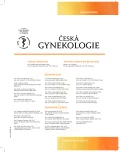Vulvar squamous precancerous lesions
History and current state of the topic
Authors:
L. Ševčík 1; P. Škapa 2; Y. Vantuchová 3; V. Benčík 4
Authors‘ workplace:
Onkogynekologická ambulance, Onkogyn, Ostrava, vedoucí lékař MUDr L. Ševčík, Ph. D.
1; Ústav patologie a molekulární medicíny 2. LF UK a FN Motol, Praha, přednosta prof. MUDr. R. Kodet, CSc.
2; Kožní oddělení FN, Ostrava, primářka MUDr. Y. Vantuchová, Ph. D.
3; Laboratoř patologie, Ben Labor, Ostrava, vedoucí lékař MUDr. V. Benčík
4
Published in:
Ceska Gynekol 2016; 81(3): 172-176
Overview
This review article discribes the genesis and development of vulvar squamous precancerous lesions terminology and discusses the consensus of the International Society for the Study of Vulvovaginal Disease, the American Society for Colposcopy and Cervical Pathology, College of American Pathologists and the World Health Organization on the current terminology. The article describes the different types of vulvar squamous precancerous lesions, according to their etiology, incidence and malignant potential.
Keywords:
vulvar intraepithelial neoplasia, differentiated vulvar intraepithelial neoplasia, lower female genital tract terminology
Sources
1. Bogliatto, F., Bohl, T., Reutter, J., et al. LAST terminology applied to the vulva: the challenge of VIN continues. J Lower Gen Tract Dis, 2015, 19, p. 47–48.
2. Carli, P., Cattaneo, A., De Magnis, A., et al. Squamous cell carcinoma arising in lichen sclerosus: A longitudinal cohort study: Eur J Cancer Prevention, 1995, 4, p. 491–495.
3. Crum, CP., Fu, YS., Levine, RU., et al. Intraepithelial squamous lesions of the vulva: biologic and histologic criteria for the distinction of condylomas from vulvar intraepithelial neoplasia. Am J Obstet Gynecol, 1982, 144, p. 77–83.
4. Crum, CP., Herrington, CS., McCluggage, WG., et al. Tumours of the vulva; epithelial tumours. In: Kurman, RJ., Carcangiu, ML., Herrington, CS., et al. WHO classification of tumours of female reproductive organs. 4th ed. Lyon: IARC Press, 2014.
5. Darragh, TM., Colgan, TJ., Thomas Cox, J., et al. Members of the LAST Project Work Groups. The lower anogenital squamous terminology standardization project for HPV-associated lesions: background and consensus recommendations from the College of American Pathologists and the American Society for Colposcopy and Cervical Pathology. Int J Gynecol Pathol, 2013, 32, p. 76–115.
6. De Sanjosé, S., Alemany, L., Ordi, J., et al. Worldwide human papillomavirus genotype attribution in over 2000 cases of intraepithelial and invasive lesions of the vulva. Eur J Cancer, 2013 49, p. 3450–3461.
7. Del Pino, M., Rodriguez-Carunchio, L., Ordi, J. Pathways of vulvar intraepithelial neoplasia and squamous cell carcinoma. Histopathology, 2013, 62, p. 161–175.
8. Eva, LJ., Ganesan, R., Chan, KK., et al. Differentiated-type vulval intraepithelial neoplasia has a high-risk association with vulvar squamous cell carcinoma. Int J Gynecol Cancer, 2009, 19, p.,741–744.
9. Friedrich, EG. Report of the committee on terminology. New nomenclature for vulvar disease. Obstet Gynecol, 1976, 47, p. 122–124.
10. Hart, WR. Vulvar intraepitelial neoplasia: historical aspects and current status. Int J Gynecol Pathol, 2001, 20, p. 16–30.
11. Pinto, AP., Miron, A., Yassin, Y., et al. Differentiated vulvar intraepithelial neoplasia contains Tp 53 mutations and is genetically linked to vulvar squamous cell carcinoma. Mod Pathol, 2010, 23, p. 404–412.
12. Scurry, J. Does lichen sclerosus play a central role in the pathogenesis of human papillomavirus negative vulvar carcinoma? The itch-scratch-lichen sclerosus hypothesis. Int J Gynecol Cancer, 1999, 9, p. 89–97.
13. Sideri, M., Jones, RW., Wilkinson, EJ., et al. Squamous vulvar intraepithelial neoplasia: 2004 modified terminology, ISSVD Vulvar Oncology Subcommittee. J Reprod Med, 2005, 50, p. 807–810.
14. Škapa, P., Pichlík, T., Pluta, M., et al. Klasifikace vulvárních prekanceróz pohledem patologa. Actual Gyn, 2014, 6, p. 26–32.
15. Škapa, P., Robová, H., Rob, L., et al. Prekancerózní léze vulvy. Cesk Patol, 2012, 48, s. 15–22.
16. Škapa, P., Zámečník, J., Hamšíková, E., et al. Human papillomavirus profiles of vulvar lesions: possible implications for the classification of vulvar squamous cell carcinoma precursors and of the efficacy for prophylactic HPV vaccination. Am J Surg Pathol, 2007, 31, p. 1834–1843.
17. Chiessa-Votero, A., Dvoretsky, PM., Hart, WR. Histopathologic study of thin vulvar squamous cell carcinomas and associated cutaneous lesions: a correlative study of 48 tumors in 44 patients with analysis of adjacent vulvar epithelial neoplasia types and lichen sclerosus. Am J Surg Pathol, 2006, 30 p. 310–318.
18. Van de Nieuwenhof, HP., van der Avoort, IA., de Hullu, JA. Review of squamous premalignant vulvar lesions. Crit Rev Oncol Hematol, 2008, 68:, p. 131–156.
19. Wilkinson, EJ., Cox, JT., Selim, MA., et al. Evolution of terminology for human-papillomavirus-infection-related vulvar squamous intraepithelial lesions. J Lower Gen Tract Dis, 2015, 19, p. 81–87.
20. Wilkinson, EJ., Kneale, B., Lynch, PJ. Report of the ISSVD terminology committee. Reprod Med, 1986, 31, p. 973–974.
Labels
Paediatric gynaecology Gynaecology and obstetrics Reproduction medicineArticle was published in
Czech Gynaecology

2016 Issue 3
Most read in this issue
- Traumatic symphyseal rupture by vaginal delivery,report of a rare case
- The possibility of antepartal prevention of episiotomy and perineal tears during delivery
- Spontaneus delivery after two previous caesarean sections – case report
- Surgical treatment of endometriomas and ovarian reserve
